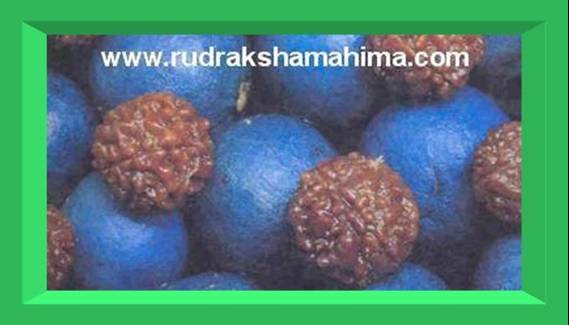![]()
Rudraksha is a fruit of the plant Elaeocarpus angustifolius (Family : Elaeocarpaceae).
This species was earlier known as Elaeocarpus ganitrus and Elaeocarpus sphericus.
Plant taxonomists have recently changed the name of these species as Elaeocarpus angustifolius.
Total 360 species are known world-wide under the genus Elaeocarpus. From India, 29 species are reported.
Elaeocarpus species are found in Nepal, India, Indonesia, Sri Lanka, Tibet, China, Australia, South America and South Africa.
In world Rudraksha trade, 75% are from Indonesia, 20% from India and other countries and hardly 5% are from Nepal.
Rudraksha is not a seed, but is a fruit. Total no. of seeds present in a Rudraksha are generally equivalent to total no. of clefts or Mukhi.

Fresh fruits of Rudraksha are deep blue in colour and look marvelous.
Therefore, Rudraksha plant is also popularly known as blue marble fruit plant.
Interestingly, this beautiful colour is not due to any plant pigments, but is due the microstructural character of cuticle and light interference.
This phenomenon is very rarely known in the plant kingdom.
This blue colour slowly changes to deep grey to black as the fruits get mature.
Dark coloured fruits are soaked in water for few days to soften this hard fibrous fruit skin.
After removing this dark cover, we get hard stony endocarp of the fruit which is popularly known as ‘Rudraksha’.
Rudraksha are of four colours, sandy white, yellowish, reddish brown and black.
Rudraksha of milky white colour is not reported. Rudraksha may be of mixed colours.
Rudraksha have many faces or mukhis from 1 to 24, Rudraksha having 27, 32 & 34 facets have also been recently reported.
Large variation in its shape and size has been observed in Rudraksha, rarely, naturally joined stones are also available.
Ishwar or Brahma, Gauri-Shankar, Ganesh-Gauri, Shiva -Ganesh and Trijuti or Gauripath are the examples of such beads.
There are three types of Rudraksha available. The most popular is Nepal type, the second is Indonesian and the third is Indian.
Nepal Rudraksha are hard, compact and look very beautiful due to high quality luster. However, these are rare and costly.
Indonesian Rudraksha are smaller in size in comparison with Nepal beads. Clefts in these are inconspicuous.
Indonesian beads are very sturdy to insect and fungus attack. Malas of these beads are convenient to wear.
Indian round Rudraksha are not beautiful in their looks and are commonly known as Indian rough beads.
These are not durable and are prone to insect and fungus attack. Indian beads are cheap in cost.
Higher Mukhi Indian beads are reported, however, the most popular Rudraksha in this type are :
Cashew nut Ek Mukhi, Shiva Pindi Ek Mukhi, Haridwar oval Ek Mukhi to three mukhi and flat Two Mukhi Rudraksha.
Cashew nut Ek Mukhi and Shiva Pindi Ek Mukhi and Flat Two Mukhi are popularly known as 'Rameshwar type of Rudraksha'.